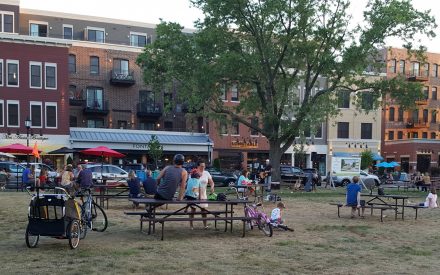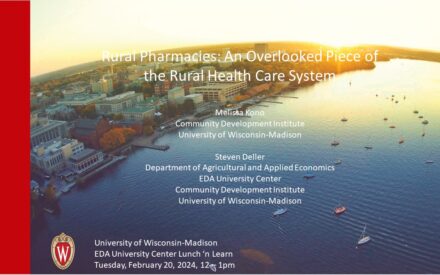
March 2022 — Statistical data assembled in your market analysis can be used to establish goals and measure progress (benchmarking) related to the downtown economy. The data can be used to create a statistical snapshot or profile to help inform prospective business operators and investors about the market as well as demonstrate downtown’s importance in the community.
This section provides a comprehensive list of metrics that can be used to compare your district’s performance over time and to determine whether your goals are being met. They can also be used in comparison with high performing peer city downtowns as a basis for refining your goals.
Benchmarking examples are published annually by downtown organizations around the country. They are typically part of an annual report and prompt dialog among stakeholders. For example, the Milwaukee Downtown BID 21 and Downtown Madison Inc. both publish economic reports that contain key metrics on their downtowns with comparisons to peer cities.
Demographics
- Total population
- Average household income
- Per capita income
- Population density
- Percentage of families in poverty
- Average household size
- Racial composition
- Educational attainment
- Population by selected age categories
- Results of qualitative surveys taken by regional or local residents
Employment Indicators
- Employment by sector
- Total employment
- Average employee weekly or annual compensation
- Percent of area employed in the district
- Unemployment rate
Investment Indicators
- Private/Public investment dollars
- Number of newly constructed buildings
- Number of newly renovated buildings
- Total square footage of newly constructed buildings
- Total construction costs of all new buildings
- Projects in the pipeline
- Real estate tax base
Housing
- Residential vacancy rates (single family, apartments, condominiums)
- Residential total square footage (single family, apartments, condominiums)
- Percentage of owner occupied housing
- Average apartment rental rate
- Average single family/condominium price per square foot
- Total residential units
Office Space
- Office vacancy rate
- Average rental rate
- Total office square footage
- Net Absorption rate
- Office space sales
- Percent share of office space located downtown
- Tenant movement into and out of the district
Note: similar statistics may be available for light industrial space downtown.
Arts and Entertainment
- Total count of theaters/performing arts venues
- Total attendance at events
- Annual receipts from events
- Annual visitor numbers for key area attractions, such as museums
- Annual receipts from key area attractions
- Annual visitor numbers for key area events (farmers markets, festivals)
- Annual count of number of special events held
- Total number of arts organizations
- Total number of art galleries
Lodging
- Hotel occupancy rate
- Average hotel room rate
- Total supply of hotels/ lodging units
- Revenue per available hotel room
- Total meeting area square footage
- Annual meeting attendance
Retail and Services
- Retail occupancy rate
- Retail vacancy rate
- Annual retail lease rate
- Number of locally owned versus franchised businesses
- Total retail square footage
- Retail turnover rate
- Annual retail growth
- Total number of retail stores by composition
- Total dollars spent, annual combined retail receipts
Restaurants
- Annual restaurant sales and growth rate
- Restaurant composition by sector (casual, fine dining, café, bar)
- Restaurant composition by style of cuisine
- Total number of bars, taverns or nightclubs
- Total number of liquor licenses issued
- Total outdoor seating
Transportation and Safety
- Total number of parking spaces
- Parking garage/parking space occupancy rate
- Traffic counts at key intersections
- Pedestrian counts at key locations
- Annual public transportation usage
- Total amount of public transportation routes
- Amount of crimes reported per capita
- Total amount of crimes reported
- Annual bicycle usage
Focus on Achieving Equitable Outcomes
According to research commissioned by the Knight Foundation, “Metrics of downtown revitalization can help cities understand their downtown’s starting point, before revitalization has taken place, to measure progress of chosen strategies, and to understand whether strategies are being applied equitably for all residents and guide any needed adjustments. Instead of every community measuring the same things, the literature advises that measures should match the strategies. Communities will need to find the best ways to measure processes and their own intended outcomes.”
The authors offer the following metrics most commonly used across the literature. “Metrics and strategies should be implemented with a focus on achieving equitable outcomes, including community representation in planning and decision-making, equitable access to the benefits of revitalization and strategies designed to limit displacement of longtime residents and businesses because of revitalization.”
For the full report, visit Revitalizing Downtowns and Neighborhoods: A Toolkit for Measuring Change
About the Toolbox and this Section
The 2022 update of the toolbox marks over two decades of change in our small city downtowns. It is designed to be a resource to help communities work with their Extension educator, consultant, or on their own to collect data, evaluate opportunities, and develop strategies to become a stronger economic and social center. It is a teaching tool to help build local capacity to make more informed decisions.
This free online resource has been developed and updated by over 100 university educators and graduate students from the University of Wisconsin – Madison, Division of Extension, the University of Minnesota Extension, the Ohio State University Extension, and Michigan State University – Extension. Other downtown and community development professionals have also contributed to its content.
The toolbox is aligned with the principles of the National Main Street Center. The Wisconsin Main Street Program was a key partner in the development of the initial release of the toolbox. One of the purposes of the toolbox has been to expand the examination of downtowns by involving university educators and researchers from a broad variety of perspectives.
The current contributors to each section are identified by name and email at the beginning of each section. For more information or to discuss a particular topic, contact us.















